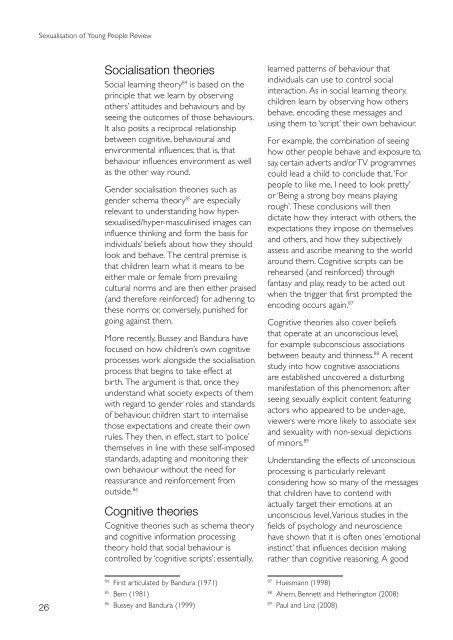Sexualisation of Young People Review
Sexualisation of Young People Review
Sexualisation of Young People Review
You also want an ePaper? Increase the reach of your titles
YUMPU automatically turns print PDFs into web optimized ePapers that Google loves.
<strong>Sexualisation</strong> <strong>of</strong> <strong>Young</strong> <strong>People</strong> <strong>Review</strong><br />
Socialisation theories<br />
Social learning theory 84 is based on the<br />
principle that we learn by observing<br />
others’ attitudes and behaviours and by<br />
seeing the outcomes <strong>of</strong> those behaviours.<br />
It also posits a reciprocal relationship<br />
between cognitive, behavioural and<br />
environmental influences; that is, that<br />
behaviour influences environment as well<br />
as the other way round.<br />
Gender socialisation theories such as<br />
gender schema theory 85 are especially<br />
relevant to understanding how hypersexualised/hyper-masculinised<br />
images can<br />
influence thinking and form the basis for<br />
individuals’ beliefs about how they should<br />
look and behave. The central premise is<br />
that children learn what it means to be<br />
either male or female from prevailing<br />
cultural norms and are then either praised<br />
(and therefore reinforced) for adhering to<br />
these norms or, conversely, punished for<br />
going against them.<br />
More recently, Bussey and Bandura have<br />
focused on how children’s own cognitive<br />
processes work alongside the socialisation<br />
process that begins to take effect at<br />
birth. The argument is that, once they<br />
understand what society expects <strong>of</strong> them<br />
with regard to gender roles and standards<br />
<strong>of</strong> behaviour, children start to internalise<br />
those expectations and create their own<br />
rules. They then, in effect, start to ‘police’<br />
themselves in line with these self-imposed<br />
standards, adapting and monitoring their<br />
own behaviour without the need for<br />
reassurance and reinforcement from<br />
outside. 86<br />
Cognitive theories<br />
Cognitive theories such as schema theory<br />
and cognitive information processing<br />
theory hold that social behaviour is<br />
controlled by ‘cognitive scripts’; essentially,<br />
learned patterns <strong>of</strong> behaviour that<br />
individuals can use to control social<br />
interaction. As in social learning theory,<br />
children learn by observing how others<br />
behave, encoding these messages and<br />
using them to ‘script’ their own behaviour.<br />
For example, the combination <strong>of</strong> seeing<br />
how other people behave and exposure to,<br />
say, certain adverts and/or TV programmes<br />
could lead a child to conclude that, ‘For<br />
people to like me, I need to look pretty’<br />
or ‘Being a strong boy means playing<br />
rough’. These conclusions will then<br />
dictate how they interact with others, the<br />
expectations they impose on themselves<br />
and others, and how they subjectively<br />
assess and ascribe meaning to the world<br />
around them. Cognitive scripts can be<br />
rehearsed (and reinforced) through<br />
fantasy and play, ready to be acted out<br />
when the trigger that first prompted the<br />
encoding occurs again. 87<br />
Cognitive theories also cover beliefs<br />
that operate at an unconscious level,<br />
for example subconscious associations<br />
between beauty and thinness. 88 A recent<br />
study into how cognitive associations<br />
are established uncovered a disturbing<br />
manifestation <strong>of</strong> this phenomenon: after<br />
seeing sexually explicit content featuring<br />
actors who appeared to be under-age,<br />
viewers were more likely to associate sex<br />
and sexuality with non-sexual depictions<br />
<strong>of</strong> minors. 89<br />
Understanding the effects <strong>of</strong> unconscious<br />
processing is particularly relevant<br />
considering how so many <strong>of</strong> the messages<br />
that children have to contend with<br />
actually target their emotions at an<br />
unconscious level. Various studies in the<br />
fields <strong>of</strong> psychology and neuroscience<br />
have shown that it is <strong>of</strong>ten ones ‘emotional<br />
instinct’ that influences decision making<br />
rather than cognitive reasoning. A good<br />
26<br />
84<br />
First articulated by Bandura (1971)<br />
85<br />
Bem (1981)<br />
86<br />
Bussey and Bandura (1999)<br />
87<br />
Huesmann (1998)<br />
88<br />
Ahern, Bennett and Hetherington (2008)<br />
89<br />
Paul and Linz (2008)

















